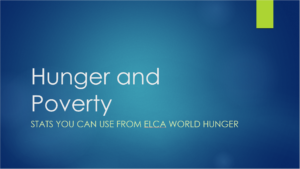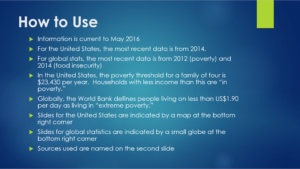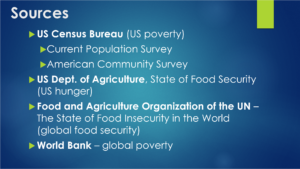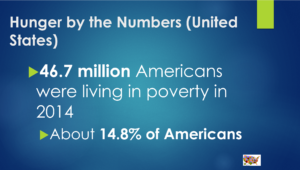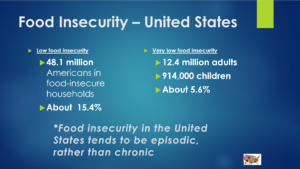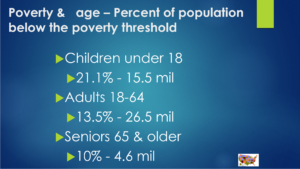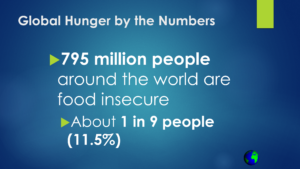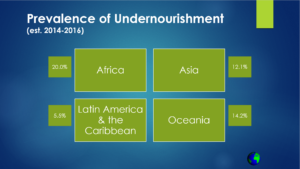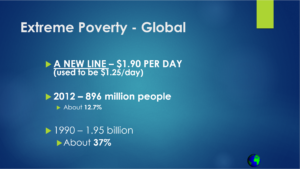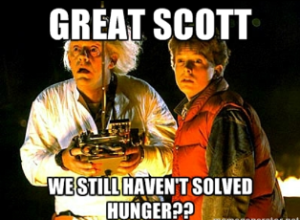When you think of hunger, what images come to mind? A line of people waiting for a meal at a soup kitchen? A bony African child pounding grain near a cook-fire? A man standing in a dry, cracked field? Something else entirely?
When we see such images, we naturally want to help. One important way to do so is to provide desperately needed relief: food, water, shelter, etc. Such immediate assistance is critical. Another important way to help is to ask how we got here and what can we do about it. Why are so many people waiting for a hot meal? How much will the dangerously thin child get to eat after spending precious energy pounding grain? What happened to destroy the man’s field and what are his options now?
There are many contributors to hunger, and they often interact in complex ways. But addressing the root causes is critical to ending hunger. My posts over the next several weeks are adapted from something I wrote a few years ago. They will introduce some of the reasons that hunger is such a tenacious problem. This first post is the longest; thanks in advance for your patience!
~~~
The Millennium Development Goals
In September of 2000, the 189 member states of the United Nations unanimously adopted eight goals that would, if accomplished, dramatically improve the lives of poor and hungry people throughout the world. To get 189 politicians to agree indicates the importance of these goals! Each one addresses an issue that affects hunger in the world. So for the purpose of this series of posts, the Millennium Development Goals provide a useful framework for considering many of the primary causes of world hunger.
Millennium Development Goal 1: Eradicate extreme poverty and hunger.
It doesn’t really get more direct than this! If someone pressed you against a wall and demanded to know the one cause of hunger, “poverty” would be an excellent answer. Obviously, people have to eat to live. So people with means will gladly buy or grow food. Meanwhile, people lacking means either can’t get food, or find that skipping food is a lesser problem than skipping something else – such as paying rent to retain shelter, paying for fuel to stay warm, or paying for child care to retain a job. In developed countries like the United States, where food is generally plentiful, hunger is frequently experienced as food insecurity. Food insecurity is “the limited or uncertain availability or ability to acquire safe, nutritious food in a socially acceptable way.” For people with inadequate income, food may be the necessity most easily skipped near the end of a pay period. That leaves people unsure how they will eat for a few days each month or periodically between jobs. In other words, they experience hunger. But as bad as it is, it could be worse. Because food is available in developed countries (there are farms, gardens, grocery stores, restaurants, etc.) and social support programs often exist, debilitating hunger and starvation are not widespread.
The same cannot be said everywhere. Poor individuals in many developing countries have it even worse. They suffer from chronic food insecurity, meaning they lack adequate food supplies not just periodically, but most of the time. Imagine this: you live in a developing country, you have very little income, and so you want a job. The thing is, there aren’t any. There’s very little infrastructure and even less industry. With almost no industry, no one is hiring and unemployment rates are very high. Besides, you are illiterate. The nearest school is miles from your village, and you were not able to go as a child. Your labor was needed on your family’s small farm. What’s more, you have periodic bouts of malaria that leave you bedridden and weak. There is no health clinic nearby or medicine to help. So even if there were jobs, you’d have a hard time getting or keeping one. When you’re well and strong enough, you still work on the farm, but the nutrients in the soil have been depleted and it produces less food each year, and you have no money to buy fertilizer. Or crop yields are low or fail altogether. Or stored food has run out and new crops are not yet ready for harvest. Most of your neighbors live under similar circumstances. All of these obstacles contribute to your poverty, and consequently, your hunger.
On an individual level, food may be unavailable or unaffordable. But widespread poverty is usually the result of systemic national problems. On a national level, such issues as unstable or corrupt governments, insurmountable national debt, trade barriers, war, disease, insufficient infrastructure, and detrimental environmental practices all contribute to poverty and food availability with a country. (Several of these will be topics of later posts in this series.) In countries lacking the resources to address national problems, poverty and hunger persist. At both an individual and national level, hunger cannot be stopped without also addressing poverty.
-Nancy Michaelis

